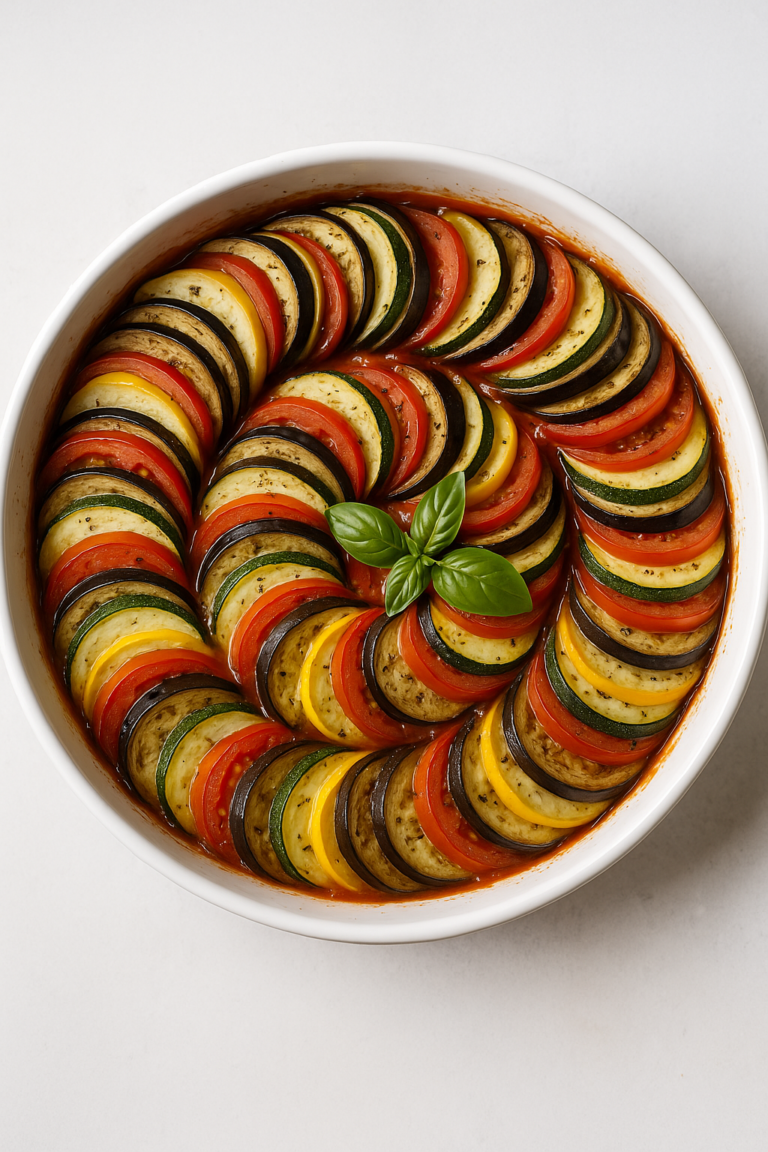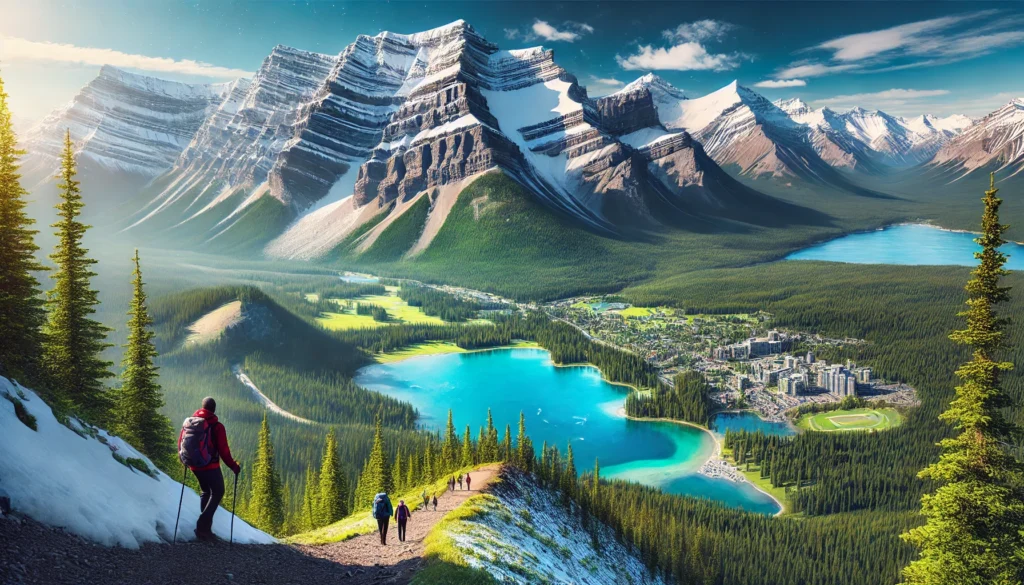
Imagine standing beneath snow-capped peaks as turquoise lakes reflect their majesty.
Banff National Park, Canada’s oldest national park, offers unforgettable adventures, pristine landscapes, and unique wildlife encounters throughout the year.
To ensure you maximize every moment of your trip, we’ve crafted this guide to help you find the best time to visit Banff and experience the Rockies like never before.
Whether you crave heart-pounding hikes, world-class skiing, or quiet moments immersed in nature, Banff has something for everyone.
Overview of Banff’s Climate and Seasons
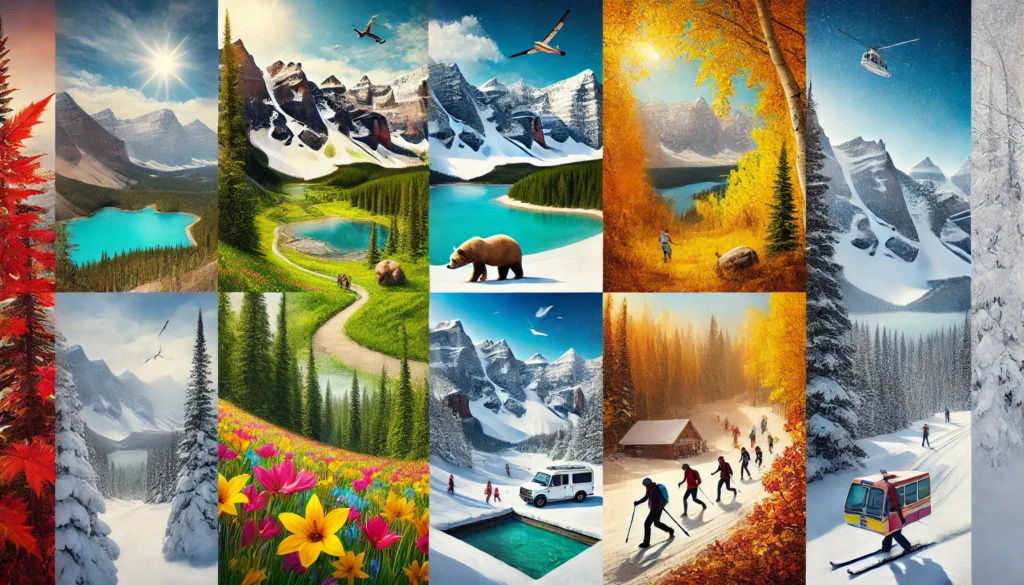
Banff National Park experiences a full spectrum of seasons, each transforming the stunning Rocky Mountain landscape into a unique playground for nature enthusiasts.
Understanding the climate throughout the year is key to making the most of your visit.
Here’s a closer look at what each season brings:
Spring (March to May)
Spring in Banff marks a period of renewal.
As temperatures begin to rise, the snow starts melting, giving way to gushing waterfalls, blooming wildflowers, and increased wildlife activity.
This transitional season offers a quieter experience compared to the busier summer months, making it an excellent time for those seeking solitude in nature.
- Temperature Range: Daytime temperatures typically range from 0°C to 15°C (32°F to 59°F). Evenings and early mornings can be chilly, so layering is recommended.
- Activities: Spring is ideal for wildlife spotting, as many animals emerge from hibernation or return to the area. Birdwatching, hiking lower-elevation trails, and visiting Banff’s renowned hot springs are popular activities.
- Pro Tip: Some higher-elevation hiking trails may still be snow-covered, so check trail conditions in advance.
Summer (June to August)
Summer is peak season in Banff, with warm temperatures, clear skies, and vibrant greenery.
This is when the park comes alive with visitors from around the globe, drawn by the chance to explore the majestic peaks, turquoise lakes, and endless trails.
While it’s the busiest time of year, summer provides unbeatable opportunities for outdoor adventure.
- Temperature Range: Daytime highs range from 15°C to 25°C (59°F to 77°F), with evenings cooling off to around 7°C to 10°C (45°F to 50°F).
- Activities: Hiking, mountain biking, kayaking, and canoeing are popular summer pastimes. Visitors flock to iconic spots like Lake Louise and Moraine Lake, and Banff’s extensive trail network offers hikes for every skill level.
- Crowd Management Tips: To avoid peak crowds, start your activities early in the morning. Consider lesser-known trails for a quieter experience.
- Nature Highlight: Wildflowers are in full bloom, painting the landscape with brilliant colors. Banff’s lakes, especially Moraine Lake and Lake Louise, are at their most photogenic during this time.
Fall (September to November)
Fall is a breathtaking time to visit Banff, as the landscape transforms into a tapestry of golds, oranges, and reds. It’s a quieter period than summer, allowing visitors to appreciate the beauty and serenity of the Rockies without the crowds. The larch trees, with their striking yellow needles, create a magical atmosphere in certain areas.
- Temperature Range: Daytime temperatures range from 5°C to 15°C (41°F to 59°F), gradually cooling as the season progresses. Nights can dip below freezing.
- Activities: Hiking remains popular, particularly for those eager to see the stunning larch trees along trails such as Larch Valley. Photography enthusiasts will find fall to be an ideal season for capturing vivid colors and wildlife.
- Pro Tip: Dress in layers and be prepared for rapidly changing weather conditions. Snow can arrive as early as October in some high-altitude areas.
Winter (December to February)
Winter in Banff is a wonderland of snow and ice, transforming the park into a paradise for winter sports enthusiasts. From December through February, the area becomes a playground for skiing, snowboarding, snowshoeing, and ice skating, all set against a backdrop of stunning snow-covered peaks.
- Temperature Range: Temperatures can range from -5°C to -20°C (23°F to -4°F), with colder snaps possible. High-altitude areas may experience even lower temperatures.
- Activities: World-class skiing and snowboarding await at resorts like Banff Sunshine Village, Lake Louise Ski Resort, and Mt. Norquay. Visitors can also enjoy ice skating on Lake Louise, snowshoeing through pristine forests, or soaking in the warm waters of the Banff Upper Hot Springs.
- Winter Safety Tips: Winter conditions can be harsh, so dress warmly in layers, and be aware of avalanche safety if venturing into backcountry areas.
- Special Events: Banff SnowDays, held in January, features stunning ice sculptures, outdoor activities, and festive events throughout the park.
By understanding Banff’s seasonal changes, visitors can tailor their trip to match their interests, whether they seek the lively bustle of summer or the tranquil beauty of fall. No matter when you go, Banff’s natural beauty ensures an unforgettable experience.
Best Times to Visit Based on Your Interests
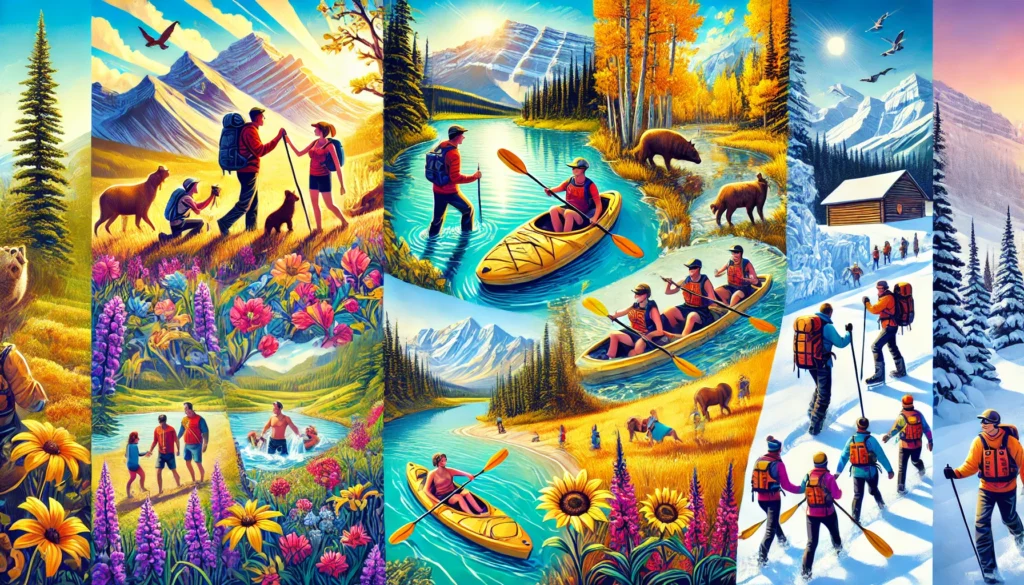
- Spring (March to May)
- Activities: Perfect for hiking, wildlife spotting (bear sightings are common), and photography. Trails start reopening.
- Pro Tip: Pack layers as temperatures can vary.
- Accommodation Picks on Expedia: Banff Springs Hotel for luxury; Banff Inn for budget-friendly stays.
- Amazon Packing Essentials: Hiking Boots (Shop on Amazon), Rain Jacket (Shop on Amazon), and Binoculars for Wildlife Spotting (Shop on Amazon).
- Summer (June to August)
- Activities: Hiking, kayaking, horseback riding, and mountain biking. Don’t miss Moraine Lake and Lake Louise.
- Pro Tip: Arrive early to beat the crowds and take advantage of early morning light for photography.
- Accommodation Picks on Expedia: Rimrock Resort Hotel for luxury seekers; Y Mountain Lodge for budget-conscious travelers.
- Essentials: Day Hiking Backpack (Shop on Amazon), Water Bottle with Filter (Shop on Amazon), and Bear Spray (Shop on Amazon).
- Fall (September to November)
- Activities: Fall foliage hikes, photography, quiet trail exploration.
- Pro Tip: Visit during late September for peak fall colors.
- Accommodation Picks on Expedia: Buffalo Mountain Lodge for a rustic experience; Banff Park Lodge for convenience.
- Essential Gear: Insulated Jacket (Shop on Amazon), Larch Hiking Guide (Shop on Amazon).
- Winter (December to February)
- Activities: Skiing, snowboarding, hot springs visits, ice skating at Lake Louise.
- Pro Tip: Book ski passes and accommodations early to secure the best deals.
- Accommodation Picks on Expedia: Fairmont Chateau Lake Louise for a premium experience; Mount Royal Hotel for cozy comfort.
- Essential Gear: Thermal Base Layers (Shop on Amazon), Ski Goggles (Shop on Amazon), and Hand Warmers (Shop on Amazon).
Pro Tips for Visiting Banff
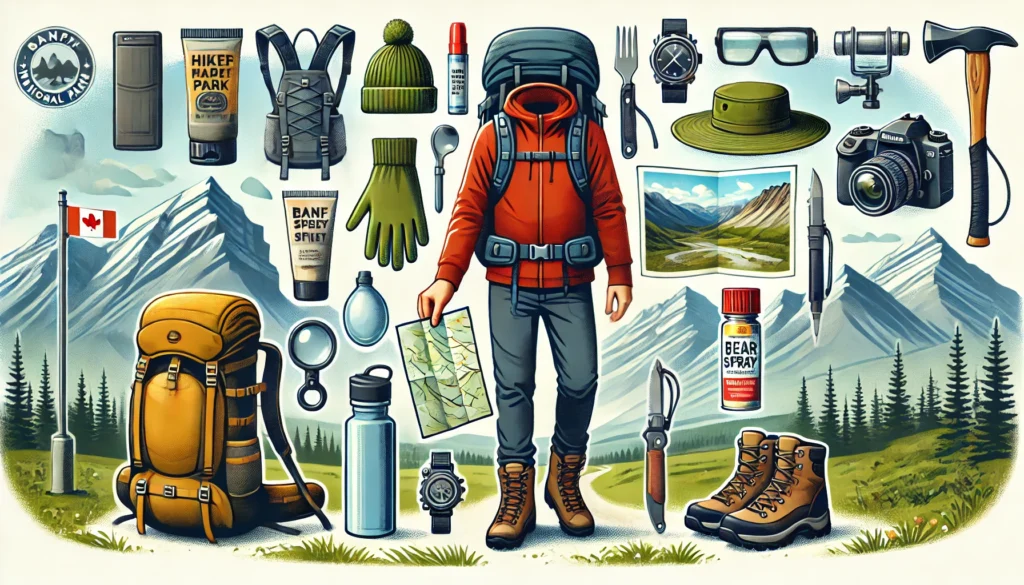
To make the most of your Banff adventure and ensure your trip is as seamless and enjoyable as possible, consider these essential tips.
Whether you’re visiting for the first time or are a seasoned traveler, these insights will enhance your experience in this stunning national park.
1. Managing Crowds
- Timing is Everything: Summer is the busiest season in Banff, so try visiting during the shoulder seasons (spring and fall) to enjoy fewer crowds while still taking advantage of beautiful weather and open trails.
- Arrive Early: Beat the rush by arriving at popular destinations like Lake Louise and Moraine Lake early in the morning, ideally before 7 AM, for a quieter experience and better parking availability.
- Consider Weekday Visits: If your schedule allows, plan your outdoor activities during weekdays. Weekends see significantly more visitors, especially during peak seasons.
2. Best Photography Spots and Times
- Golden Hours: The best light for capturing Banff’s stunning landscapes is during sunrise and sunset. Catching the first light over Moraine Lake or Lake Louise makes for unforgettable photos.
- Top Spots: Don’t miss iconic spots like Bow Lake, Vermilion Lakes, and the Banff Gondola viewpoint. Johnston Canyon also offers excellent opportunities, especially in winter when frozen waterfalls create a breathtaking scene.
- Pro Tip: Bring a sturdy tripod for capturing long-exposure shots and sunrise/sunset photos.
3. Pack Smart
- Layer Up: Banff’s weather can change rapidly, even within a single day. Pack clothing that can be easily layered, such as moisture-wicking base layers, insulated jackets, and rain gear.
- Footwear: Comfortable and sturdy hiking boots are a must for exploring Banff’s trails. For winter, consider packing microspikes or crampons for icy paths.
- Bear Safety Gear: Carry bear spray, know how to use it, and keep it accessible. It’s essential when hiking in Banff’s backcountry.
- Reusable Essentials: Banff National Park is committed to environmental protection. Bring a reusable water bottle and food containers to minimize your ecological footprint.
4. Wildlife Safety
- Keep a Safe Distance: Observe wildlife from a safe distance. Approaching animals can be dangerous for both you and the wildlife. Carry binoculars for safe viewing.
- No Feeding: Do not feed wildlife under any circumstances. It can harm their health, cause dependency, and lead to dangerous encounters.
- Wildlife Corridors: Be aware of wildlife corridors and crossings. Driving slowly, especially at dawn and dusk, can help prevent accidents.
5. Know the Rules and Regulations
- Parks Canada Pass: Purchase your Parks Canada Discovery Pass before entering the park. It gives you access to Banff and other national parks across Canada.
- Leave No Trace: Follow Leave No Trace principles to help keep Banff pristine for future generations. Carry out all trash, stick to marked trails, and respect wildlife.
- Campfire Restrictions: Familiarize yourself with fire regulations, especially during dry months when campfire bans may be in place.
6. Transportation Tips
- Use Public Transit: Banff offers excellent shuttle services to popular spots like Lake Louise and Moraine Lake, especially during peak season when parking is limited. Taking the shuttle reduces stress and your environmental impact.
- Biking: Consider renting a bike to explore the town of Banff and nearby trails, minimizing car use and enjoying breathtaking views along the way.
- Winter Travel: Winter road conditions can be challenging. Consider renting a vehicle with snow tires or using shuttle services if you’re unfamiliar with winter driving.
7. Food and Dining Tips
- Stock Up: Grocery stores and restaurants can be expensive in Banff. Consider stocking up on snacks and meals in nearby towns if you’re on a budget.
- Reservations: During peak seasons, it’s best to make dining reservations ahead of time to secure your spot at popular eateries.
- Picnic Spots: Banff offers many scenic picnic spots. Pack a meal and enjoy dining al fresco surrounded by mountains.
8. Seasonal Preparedness
- Spring and Fall: Pack for variable conditions. Snow may still linger on higher-elevation trails, so check weather forecasts and trail conditions.
- Summer: Bring sunscreen, a wide-brimmed hat, and insect repellent. The high-altitude sun is strong, and mosquitoes can be a nuisance.
- Winter: Layer up and bring thermal clothing, gloves, and warm footwear. Don’t forget to check avalanche conditions if you plan on backcountry activities.
9. Maximize Your Time
- Plan Ahead: Research the attractions you want to see and make an itinerary. Be prepared for flexibility based on weather and conditions.
- Local Knowledge: Chat with locals or park staff for insider tips on lesser-known hikes or must-see spots.
- Guided Tours: Consider booking guided tours to maximize your experience and learn more about the area’s natural history, wildlife, and culture.
By following these pro tips, you’ll ensure a memorable, safe, and enriching visit to Banff.
The park’s beauty is unmatched, and thoughtful planning will help you experience it to the fullest.
Whether you’re there for thrilling outdoor adventures, wildlife encounters, or serene moments by a turquoise lake, Banff is ready to leave a lasting impression.
Seasonal Events and Festivals
- Spring: Banff Film Festival (April).
- Summer: Canada Day celebrations, outdoor concerts, and summer hiking challenges.
- Fall: Taste of Banff food festival.
- Winter: Banff SnowDays (January).
Budget Considerations and Travel Tips
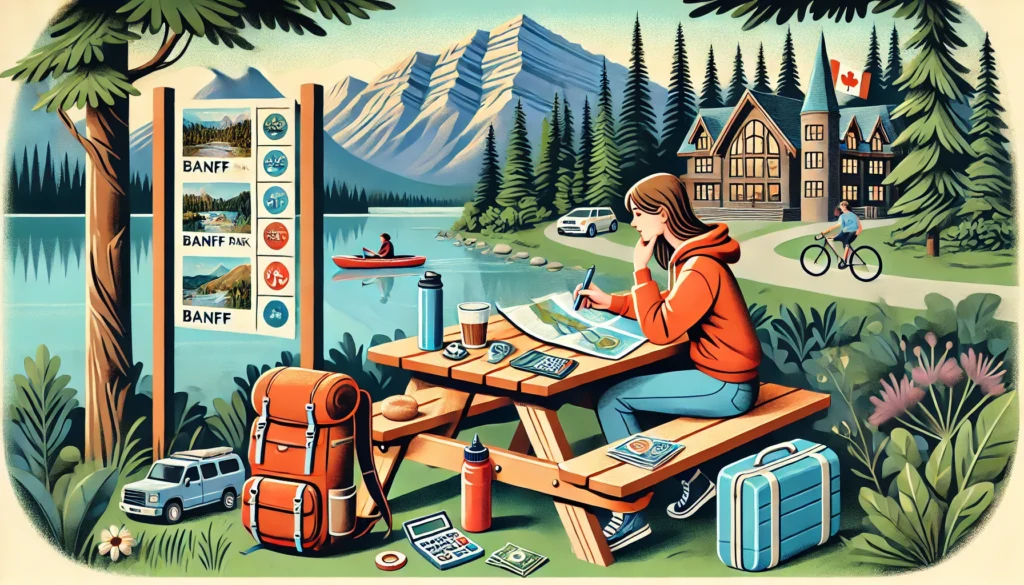
Visiting Banff can be an unforgettable experience, but like many popular travel destinations, the costs can add up quickly.
However, with a little planning and some strategic tips, you can enjoy this beautiful national park without breaking the bank.
Here’s how to budget effectively for your trip to Banff and make the most of your money while experiencing everything the Rockies have to offer.
1. Save on Accommodation
Banff offers a wide range of accommodation options, but prices can vary significantly depending on the season.
Here are some strategies to find the best deals:
- Off-Season Savings: The peak season in Banff typically spans from June to August. If you’re looking to save on lodging, consider traveling in the shoulder seasons (spring or fall). These months offer fewer crowds and more affordable accommodation rates, with many hotels offering discounted rates.
- Alternative Stays: If you’re on a tight budget, look for more affordable options like hostels, motels, or Airbnb rentals. Banff National Park and the nearby towns of Canmore and Lake Louise have plenty of budget-friendly accommodations that are a short drive from the park’s main attractions.
- Book in Advance: Accommodation in Banff can fill up quickly during peak seasons. To avoid high last-minute prices, book as far in advance as possible. Expedia often offers deals for early bookings, which can help you secure lower rates.
2. Use Public Transportation
Parking in Banff National Park can be a challenge, especially during the summer months when visitors flock to the most popular spots.
Here’s how you can save money and avoid the hassle:
- Banff Shuttle Service: During the high season, Banff’s shuttle services make it easy to get around without needing a car. Shuttles run to key destinations like Lake Louise, Moraine Lake, and the Banff Gondola. By using this service, you can avoid expensive parking fees and gas costs.
- Trans-Canada Highway: If you’re traveling to Banff by car, it’s often more affordable than flying. However, consider renting a car with a fuel-efficient engine and using it only for exploring areas outside of Banff town to save on parking costs.
- Carpooling: If you’re visiting with a group, consider carpooling to split the cost of gas and parking fees.
3. Plan Your Meals Wisely
Food costs in Banff can be high, especially in tourist-heavy areas.
To help keep your food expenses under control, consider the following tips:
- Grocery Stores: Stock up on groceries in the nearby town of Canmore or Calgary (if you’re driving through). You’ll find affordable options at local grocery stores like Safeway and IGA. Preparing your own meals in the comfort of your accommodation can help you save a significant amount.
- Picnic Lunches: Banff offers plenty of stunning picnic spots. Pack a lunch with sandwiches, snacks, and drinks from the grocery store, and enjoy a meal surrounded by breathtaking mountain views. This will save you the cost of dining out.
- Affordable Dining: Banff has some budget-friendly restaurants where you can get delicious meals without spending a fortune. Look for cafes or casual eateries, which tend to have lower prices than fine dining options. Popular budget spots include The Bear Street Tavern for casual bites and The Grizzly House for an affordable but unique experience.
4. Skip the Expensive Guided Tours
Banff offers many paid guided tours that can add up, especially for families or groups. Instead, consider these more affordable options:
- Self-Guided Tours: With the help of free resources like the Banff Visitor Center or mobile apps, you can create your own hiking or sightseeing itinerary. Most of the trails in Banff are accessible without a guide, and you can enjoy the freedom of exploring at your own pace.
- Free Attractions: Banff National Park offers a range of beautiful spots that require no entry fee, such as the Banff Springs Hotel, the Bow River, and the famous Banff Avenue. Hikes like Johnston Canyon and Tunnel Mountain are free to access and provide stunning views.
- Discounted Activities: If you’re determined to experience a guided activity, keep an eye out for deals and packages, especially if you’re booking in advance. Many tour operators offer discounted rates for group bookings or multi-day packages.
5. Take Advantage of Parks Canada Pass
To enter Banff National Park, you’ll need a Parks Canada Discovery Pass.
While this pass comes with a cost, it’s well worth the price as it grants access to Banff, Yoho, and Kootenay National Parks for up to 12 months.
- Annual Pass: If you’re planning on visiting multiple national parks or are staying for an extended period, the Discovery Pass can save you money compared to daily entry fees. The pass costs approximately $139.40 CAD for a family, or $72.25 CAD for an adult (prices may vary).
- Family-Friendly Savings: The Discovery Pass offers great value for families, as children 17 and under get free access to national parks.
6. Budget for Activities
While many of Banff’s natural attractions are free, some activities, like skiing, mountain biking, and guided tours, can be expensive.
Here are some budget-friendly alternatives:
- Free Outdoor Activities: Many of Banff’s most scenic hikes, like Lake Louise Lakeshore Trail, Banff Legacy Trail, and Cascade Ponds are free to explore. Banff also offers free access to cross-country skiing in the winter, as well as some beautiful ice skating rinks in the town.
- Discounted Tickets for Paid Activities: If you plan to indulge in activities like the Banff Gondola or Lake Louise Ski Resort, check for deals or discounts on tickets through third-party vendors like Expedia or Viator. Often, you can save by purchasing tickets in advance or booking packages that combine multiple experiences.
Book Activities with Discounts: Find Deals on Tours & Tickets
7. Travel Insurance
When traveling to a remote location like Banff, it’s wise to invest in travel insurance.
This can help mitigate unexpected costs related to cancellations, medical emergencies, or trip interruptions.
- Affordable Options: Shop around for the best coverage for your needs. Many travel insurance companies offer affordable plans for both short and long stays, and the peace of mind is invaluable when traveling in remote areas.
- Emergency Medical Coverage: Banff is located in a national park, so if you plan on doing outdoor activities like hiking or skiing, ensure your insurance includes emergency medical coverage for outdoor accidents.
By following these budgeting tips, you can enjoy Banff’s breathtaking beauty and exhilarating activities without overspending.
Whether you’re staying in a cozy lodge, hiking free trails, or preparing your own meals, there are plenty of ways to experience Banff without breaking your budget.
So go ahead and start planning your affordable Rocky Mountain getaway!
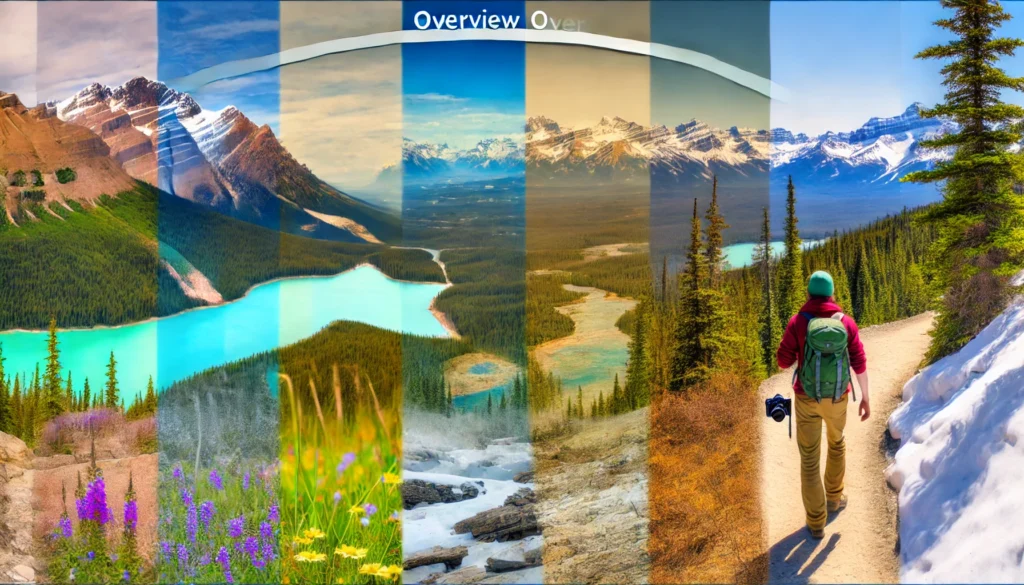
Conclusion: Best Time to Visit Banff
No matter when you visit, Banff promises a stunning experience.
By choosing the right time for your interests, you can truly experience the Rockies like never before.
Start planning your adventure today!
Check These Out Too!
Hiking Boots for Men: Top 10 Picks for Every Trail Adventure
Selecting the Right Hiking Boots for Women
Hiking Clothes That Keep You Warm and Dry: A Must-Have List
As an Amazon Associate, I earn from qualifying purchases.


